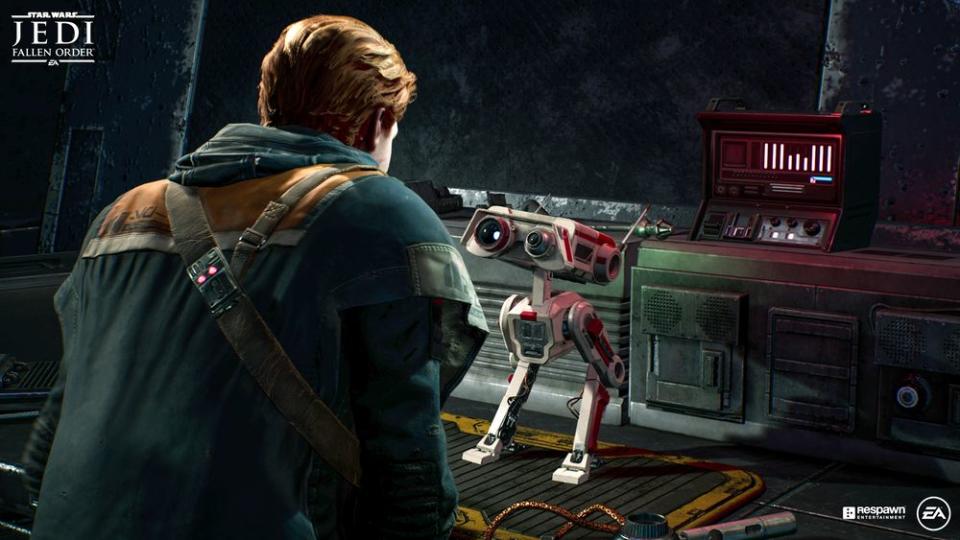In Star Wars Jedi: Fallen Order, the Force is strong but undisciplined: Review
There are moments of pure Star Wars joy in Jedi: Fallen Order. From smaller instances like Force-pushing an entire team of stormtroopers off a cliff to larger endeavors like venturing to the hallowed Jedi world of Ilum in search of a kyber crystal, developer Respawn has fully embraced the tone and aesthetic of the venerable franchise. A squadron of technical issues and some questionable level design, however, nearly relegate this otherwise highly enjoyable experience to the dark side of Star Wars branded content.
Set about five years after Emperor Palpatine’s Jedi-exterminating Order 66, Fallen Order follows Cal Kestis (Cameron Monaghan), a former padawan who survived the massacre and went into hiding as a backwater scrapper. When Cal is discovered by the Empire’s Inquisitors, he’s rescued by Cere, a former Jedi with a dark past, and Greez, the plucky four-armed captain of the Mantis. Cere then recruits Cal to participate in a mission to recover an artifact that could help to rekindle the Jedi Order. As Cal collects what he needs to acquire the Jedi artifact, the crew of the Mantis is pursued by the Inquisitorius’ Second Sister, who has a deeply personal interest in the trio’s mission.
Despite the knowledge that, canonically speaking, Cal and Cere can’t succeed in reestablishing the Jedi, the story works on a character level since the main trio of Cal, Cere and Greez are endearing and well acted. I’d also be remiss not to mention Cal’s companion BD-1, who is quite possibly the best, cutest droid in all of Star Wars continuity. From the moment I saw BD, I would have died for the little guy.

In the same way the Star Wars movies are designed to evoke old-school swashbuckling adventures, Fallen Order feels like it was built to be reminiscent of old-school, broad-appeal adventure games. There’s something for everyone here, from lightsaber combat to Force-power puzzle rooms to acrobatic platforming. Not everything works perfectly, but it all goes well enough together that it feels like a cohesive package.
Cal’s journey takes him from planet to planet, some familiar to Star Wars fans like the Wookiee homeworld of Kashyyyk, and some brand new like the home world of an ancient species of Force sensitives called the Zeffo. Scattered throughout these worlds are various upgrades Cal and BD will need to progress deeper into certain environments. Some of these power upgrades are housed inside Zelda-style puzzle dungeons built around the newfound item or ability.
One of the game’s best features, its map, helps to manage any frustration that might come from this sort of gear gating by clearly indicating which exits to a room are accessible with Cal’s current gear and which will require more equipment to explore. But even with this UI clarity, it can be a hassle to have to backtrack all the way through an area just to get to the one door Cal couldn’t open on his first pass.

Early on, the combat feels like a poor man’s Sekiro, complete with blocking, dodging, parrying, and powerful finishing blows. Lightsaber fighting can be deeply satisfying when everything clicks, but the mechanics don’t always play nice with each other. Once Cal has earned a few skill points and gained Force abilities like push and pull, combat becomes more versatile and engaging, but the baseline experience feels slightly lacking. The window for parrying enemies is forgiving, especially on lower difficulty settings, but the parry animation itself is sluggish, so deflecting an enemy’s blow becomes more of a premeditated choice than a reflexive reaction. Pair this with a long lag time between lowering Cal’s guard and being able to parry, and combat can feel awkward against quicker enemies or large groups.
The game’s platforming, likewise, is mostly satisfying with a few caveats. Prince of Persia-style wall runs and rope swings give Cal the agility expected of a young Jedi. Unfortunately, more complex platforming sequences are often mired down by the game’s plentiful physics glitches and frame rate drops. Cal will oddly bounce off of things it seems like he ought to be able to land on, and hitboxes for some platforming objects like ropes can be difficult to comprehend. There’s even a boss fight that involves a series of long-distance jumps toward a moving target, and that target’s hitbox is not easily recognizable. I probably fell a dozen times just trying to figure out where I was supposed to try to land.
Numerous platforming set piece areas are also built around sliding down slopes, sometimes on muddy hillsides, sometimes in icy caves. These areas require an amount of precision that is not commensurate with how poorly they control, but luckily, despite how strangely frequent they are, each slide area is blessedly short.
Hopefully frame rate improvements and bug fixes will be patched in sooner rather than later, but as it stands now, Fallen Order feels like it’s just short of ready for primetime on standard PS4 hardware. This is a shame, because the game does plenty right; it may be the most immersed in the Star Wars galaxy I’ve ever felt while playing a game. That the Star Wars immersion and sense of wonder still shine clearly through despite all its technical flaws speaks to what Fallen Order could and should be, but isn’t quite yet. B-
Related content:

